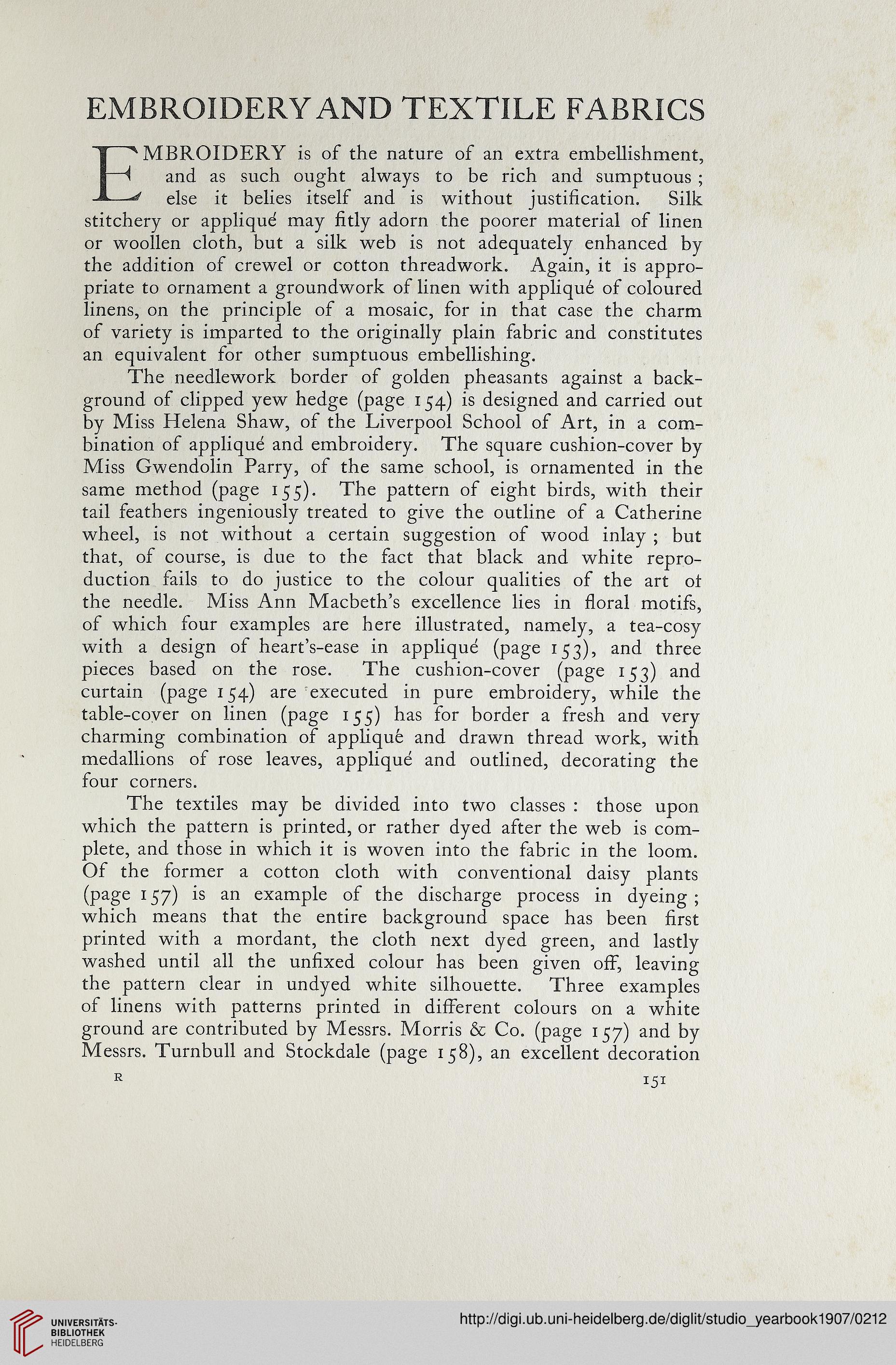EMBROIDERY AND TEXTILE FABRICS
Embroidery is of the nature of an extra embellishment,
and as such ought always to be rich and sumptuous ;
else it belies itself and is without justification. Silk
stitchery or appliqud may fitly adorn the poorer material of linen
or woollen cloth, but a silk web is not adequately enhanced by
the addition of crewel or cotton threadwork. Again, it is appro-
priate to ornament a groundwork of linen with appliqud of coloured
linens, on the principle of a mosaic, for in that case the charm
of variety is imparted to the originally plain fabric and constitutes
an equivalent for other sumptuous embellishing.
The needlework border of golden pheasants against a back-
ground of clipped yew hedge (page 154) is designed and carried out
by Miss Helena Shaw, of the Liverpool School of Art, in a com-
bination of applique and embroidery. The square cushion-cover by
Miss Gwendolin Parry, of the same school, is ornamented in the
same method (page 155). The pattern of eight birds, with their
tail feathers ingeniously treated to give the outline of a Catherine
wheel, is not without a certain suggestion of wood inlay ; but
that, of course, is due to the fact that black and white repro-
duction fails to do justice to the colour qualities of the art ol
the needle. Miss Ann Macbeth’s excellence lies in floral motifs,
of which four examples are here illustrated, namely, a tea-cosy
with a design of heart’s-ease in applique (page 153), and three
pieces based on the rose. The cushion-cover (page 153) and
curtain (page 154) are executed in pure embroidery, while the
table-cover on linen (page 155) has for border a fresh and very
charming combination of applique and drawn thread work, with
medallions of rose leaves, applique and outlined, decorating the
four corners.
The textiles may be divided into two classes : those upon
which the pattern is printed, or rather dyed after the web is com-
plete, and those in which it is woven into the fabric in the loom.
Of the former a cotton cloth with conventional daisy plants
(page 157) is an example of the discharge process in dyeing ;
which means that the entire background space has been first
printed with a mordant, the cloth next dyed green, and lastly
washed until all the unfixed colour has been given off, leaving
the pattern clear in undyed white silhouette. Three examples
of linens with patterns printed in different colours on a white
ground are contributed by Messrs. Morris & Co. (page 157) and by
Messrs. Turnbull and Stockdale (page 158), an excellent decoration
Hi
R
Embroidery is of the nature of an extra embellishment,
and as such ought always to be rich and sumptuous ;
else it belies itself and is without justification. Silk
stitchery or appliqud may fitly adorn the poorer material of linen
or woollen cloth, but a silk web is not adequately enhanced by
the addition of crewel or cotton threadwork. Again, it is appro-
priate to ornament a groundwork of linen with appliqud of coloured
linens, on the principle of a mosaic, for in that case the charm
of variety is imparted to the originally plain fabric and constitutes
an equivalent for other sumptuous embellishing.
The needlework border of golden pheasants against a back-
ground of clipped yew hedge (page 154) is designed and carried out
by Miss Helena Shaw, of the Liverpool School of Art, in a com-
bination of applique and embroidery. The square cushion-cover by
Miss Gwendolin Parry, of the same school, is ornamented in the
same method (page 155). The pattern of eight birds, with their
tail feathers ingeniously treated to give the outline of a Catherine
wheel, is not without a certain suggestion of wood inlay ; but
that, of course, is due to the fact that black and white repro-
duction fails to do justice to the colour qualities of the art ol
the needle. Miss Ann Macbeth’s excellence lies in floral motifs,
of which four examples are here illustrated, namely, a tea-cosy
with a design of heart’s-ease in applique (page 153), and three
pieces based on the rose. The cushion-cover (page 153) and
curtain (page 154) are executed in pure embroidery, while the
table-cover on linen (page 155) has for border a fresh and very
charming combination of applique and drawn thread work, with
medallions of rose leaves, applique and outlined, decorating the
four corners.
The textiles may be divided into two classes : those upon
which the pattern is printed, or rather dyed after the web is com-
plete, and those in which it is woven into the fabric in the loom.
Of the former a cotton cloth with conventional daisy plants
(page 157) is an example of the discharge process in dyeing ;
which means that the entire background space has been first
printed with a mordant, the cloth next dyed green, and lastly
washed until all the unfixed colour has been given off, leaving
the pattern clear in undyed white silhouette. Three examples
of linens with patterns printed in different colours on a white
ground are contributed by Messrs. Morris & Co. (page 157) and by
Messrs. Turnbull and Stockdale (page 158), an excellent decoration
Hi
R





